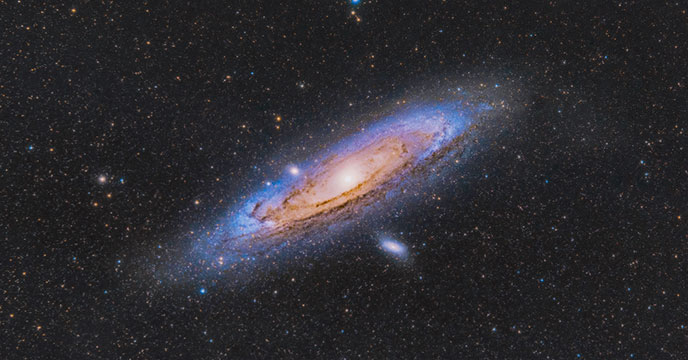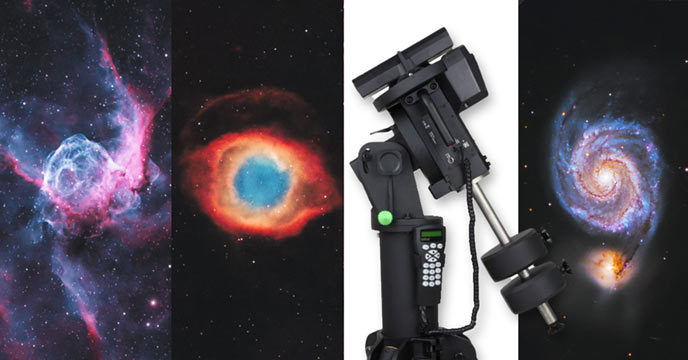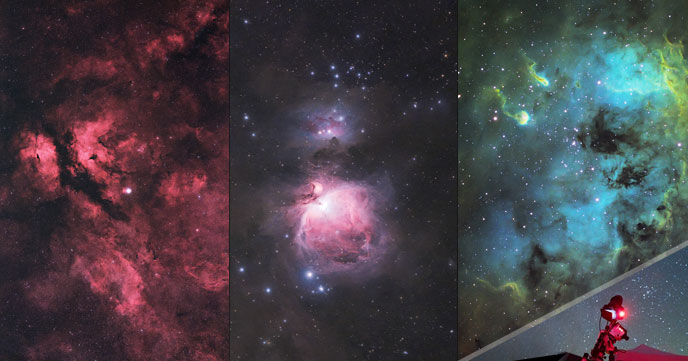My Best Image of the Andromeda Galaxy Yet

My latest photo of the Andromeda Galaxy is my best effort yet. I have been taking deep-sky astrophotography images for over 10 years now, and this might be my favorite photo of space I’ve ever taken.
This detailed image was captured using a small refractor telescope, with a mirrorless camera attached. The image reveals the incredible, dusty spiral arms of Andromeda, in incredible detail.
On October 17th, 2020, I rented a one-bedroom Airbnb to photograph the Andromeda Galaxy under dark skies. I spent the entire night outside collecting images of this galaxy with my camera and telescope.
The Andromeda Galaxy. Trevor Jones (Click to enlarge)
I’ll never take an image of Andromeda that can compete with NASA, but I can certainly continue to improve upon my previous efforts and capture the best shot I possibly can.
I believe that the planning that went into the shot, and my always-evolving image-processing techniques are the reason this shot was so successful. If you have questions about how I captured and processed the image, please feel free to leave a comment.
The Andromeda Galaxy
Messier 31 is classified as a spiral galaxy, but it looks elliptical because it is tilted at an angle from our vantage point on Earth. This galaxy is extremely bright compared to most others we see in the night sky.
The galaxy lies 2.5 million light-years away from us, and it is similar to our own Milky Way Galaxy. On a clear night under the right conditions, the Andromeda Galaxy can be seen with the naked eye.
Through a telescope or a pair of binoculars, the galaxy will appear as a noticeable “smudge”, which is the bright central core of Andromeda. Only through astrophotography, can we reveal the faint out spiral arms of the galaxy.
Although the sky was clear and beautiful the night this image was taken, stargazing was low on my priority list.
I had to make sure all of my astrophotography equipment was running properly to maximize the amount of exposure time collected on M31 in a single night.
Setting up my telescope at a dark sky location to photograph Andromeda.
About The Image
Over the past 10 years, I have photographed the Andromeda Galaxy many times, and I am proud to say that my images of M31 are improving each year. The key to this image was planning and the right approach.
This time around, I traveled to a dark sky location to capture Andromeda in all its glory. The site was a Bortle Scale Class 4, which has much less light pollution than my backyard in the city (Bortle 7).
Many astrophotographers struggle with the negative effects of light pollution, and escaping to darker skies means packing up your gear and heading away from the city.
The Bortle Scale Class 4 rural location where the photo was taken.
The dark, rural skies allowed me to capture longer exposures of my target, with better contrast. This reduced the amount of skyglow and unwanted artificial light collected in each long exposure photo I took.
To effectively photograph broadband (or broad spectrum) true-color objects in space, shooting from a dark sky site will provide the biggest advantage.
Narrowband filters can help you collect great data from the city, but galaxies and reflection nebulae do not benefit from this type of filtering. This is what makes photographing galaxies so challenging.
In total, I collected 60 image exposures that were 180-seconds long each.
The individual 3-minute sub-exposures (light frames) of my image.
This sub-exposure length was selected to find a balance between dynamic range, noise, and tracking accuracy. The Canon EOS Ra camera used for this image handles noise at higher ISOs exceptionally well.
The “best” exposure length to use for deep-sky astrophotography will be debated for eternity, but the camera settings used for my Andromeda Galaxy photo may be a useful benchmark for you to use during your next astrophotography project.
The camera used for my photo (Canon EOS Ra full-frame mirrorless camera).
Recommended Camera Settings
- File Format: RAW
- Mode: Bulb
- Focus: Manual
- Exposure: 3-minutes
- ISO: 1600
- White Balance: Daytime
- Number of Exposures: 60
The settings above assume you are using an equatorial telescope mount or star tracker to match the apparent rotation of the night sky. These settings will vary widely depending on the aperture of your telescope/lens, your shooting conditions, and the camera used.
Use the histogram to help you determine an appropriate exposure length that does not clip the shadows or highlights of the data. Through image stacking, it is possible to integrate several hours’ worth of exposures into a single image with reduced noise, and plenty of signal (light).
The Equipment Used
The deep-sky astrophotography equipment used for this photo was specifically selected for this project. The telescope (Radian 61 APO) shoots at an incredibly wide focal length of 250mm, at a focal ratio of F/4.5.
This refractor is capable of capturing stunning, flat-field images of deep-sky objects in space with impressive color correction. When using a full-frame camera like the Canon EOS Ra, the backspacing and tilt of the imaging sensor must be perfect for edge-to-edge performance.
The equipment used for my latest photo of Andromeda.
I did not use a light pollution filter inside of the built-in filter vault, opting to deal with any unwanted skyglow during the image processing stage. Collecting 60 sub-exposures was enough to produce a clean image without any serious noise issues.
The camera and telescope accurately tracked the apparent rotation of the night on an equatorial telescope mount, the Sky-Watcher EQ6-R Pro. A small guide scope and guide camera were used to provide better tracking (autoguiding) and utilize dithering.
My Deep-Sky Setup
- Camera: Canon EOS Ra
- Telescope: Radian 61 APO
- Mount: Sky-Watcher EQ6-R
- Guide Scope: Starfield 50mm
- Guide Camera: ZWO 120MM Mini
Image Processing Tips
To process the image, I used many of the techniques I’ve described in detail in my premium image processing guide, as well as a few new tricks. The exposures were stacked in DeepSkyStacker using dark frames for calibration, which produced an intermediate file with a healthy signal-to-noise ratio.
For my tastes, I believe the key to a pleasing image of the Andromeda Galaxy is to reveal the gorgeous cool colors in the spiral arms of the galaxy, and really accentuate them. This creates a beautiful play of warm and cool colors that help to show the contrasting values of light from the galaxy core to the outer rim.
For many amateur astrophotographers, one of the more difficult challenges of photographing the Andromeda Galaxy is fitting the entire disc of the galaxy in a single image frame. For this reason, a wide field imaging refractor or a telephoto lens of no more than 400mm is ideal.
Reducing star size, using layer masks to protect the bright core, and a saturation boost to taste were all applied several times over to create the final image. Several hours of processing (over many days) were involved in the creation of this image. I hope you enjoy it!
I regularly share my astrophotography adventures on YouTube. You can also see my latest images on Instagram, Twitter, and Facebook.













Fantastic image! I agree about accentuating the subtle colors on the outer areas to make the image pop.
I have just started my astrophotography journey (although I have had an interest in astronomy for over 30 years) with the recent purchase of the WO GT81 and assorted gear. My very first image was of the Andromeda Galaxy, taken only a few weeks back. I’ve not had he opportunity to get out out again since, so it remains my only image so far. I jumped straight in, taking plenty of subs, and dark frames, and even gave auto guiding a go with PHD2, with moderate success.
I have been following your blogs, etc for the last few month or so, and must say, they are very informative and enjoyable to read/watch. They are especially enjoyable to me because I live just across the lake from you in Erie (sorry for the light pollution, on behalf of all Erieites).
I am looking forward to seeing more of your content as things progress with your backyard observatory, but please don’t forget about us newbies!
Thank you so much, Dennis. I am glad to hear that you have caught the astrophotography bug and are well on your way. The next time I am shooting the Milky Way over Lake Erie I may send you a quick message to turn your porch light off! 😀
Hello Trevor!
Very nice image, congratulations!
Please, you were mentioning in the video at 6:43 some research about the beginning of the merger of Milky way and Andromeda galaxies, could you share more? Where were you reading about it?
Also, you said you were only using dark frames (apart from light frames), correct? Do you think one could even do without the dark frames? I mean, did they substantially help?
Thanks and clear skies!
Hello Trevor,
Very nice photo. I am a regular to you youtube channel since last April and your passion inspired me to start my own journey but its so hard to get my hands on a decent telescope here in Melbourne since start of pandemic. I wonder if all Aussies are stargazing while in lockdown
Great image! what a luxury to get into really dark skies, I’m living in the most crowded part of the Netherlands, my backyard is Bortle 8ish 😭, so struggling against light pollution and clouded skies… But about the video; in general I would love to see more about the processing you do afterwards. It’s a huge part from the final result and it stays ‘covered’ in a lot of your videos. From your backyard we suddenly get a beautiful image, but I would love to see more about the processing you did. Maybe a separate video?
Thanks too you I’m taking babysteps into astrophotography, so thank you for that!
Do you sell your images?
I am interested in several.
Just a quick note (I’d like to talk with you, in depth, eventually!) – I’m a, “semi-retired”, Amateur Astronomer, now, writing for Insight Observatory’s website.
Your M31 imaging is, unique, in, your capture of the blue hues at the galaxy’s perimeter. Fabulous!
Hello
I enquire if your Andromeda photo is copyrighted? I am looking for a single image to be inserted in an semi-autobiographical, philosophical, part technical, book I am writing for the general public.
It would be used as a small photo, with epigraph, credited, placed centre in a short Prologue –
Prologue
pic
short explanation of content
Chapter One: The Theatre of Uncertainty
Please advise